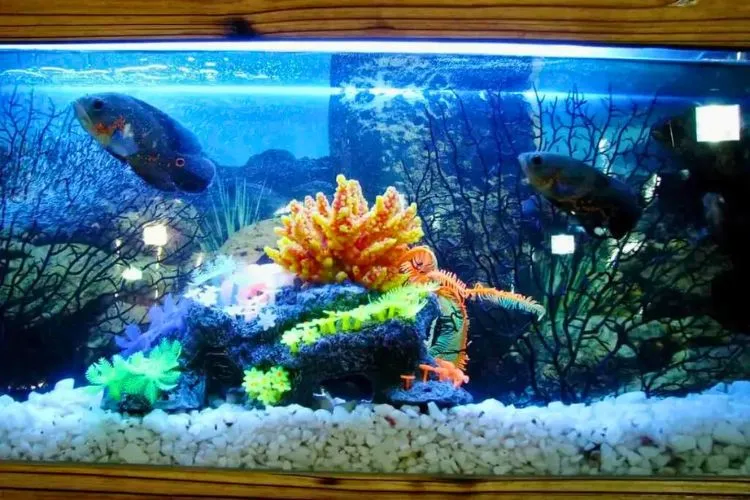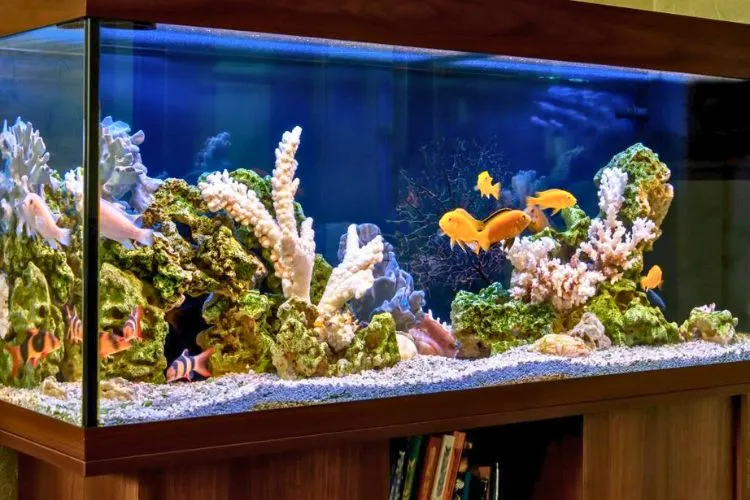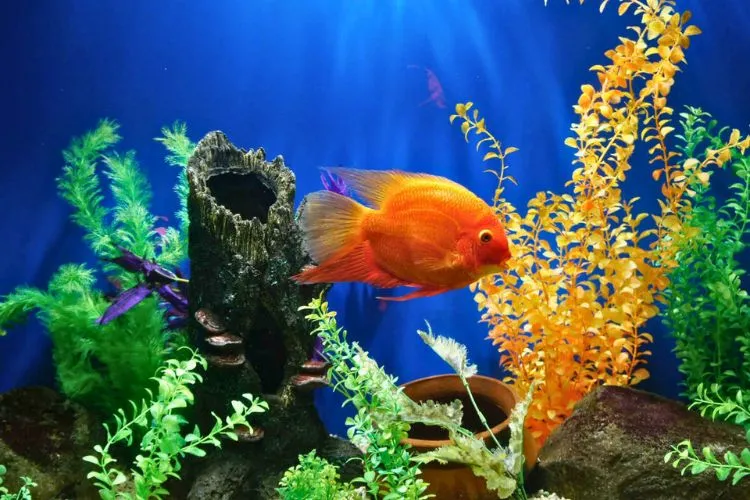Understanding the intricate details and safety considerations of maintaining an aquarium is crucial for hobbyists and professional aquarists alike.
One common question frequently asked is the safety of using acrylic paint in fish tanks.
So, is acrylic paint safe for aquariums?
Although acrylic paint is favored for being quick-drying and durable, its safety for aquatic life needs examination.

This article aims to provide an evidence-based analysis on this subject, to assist in making informed decisions regarding aquarium design and maintenance.
The Safety of Acrylic Paint for Aquariums
When choosing paint for decorating your aquarium, acrylic paint often comes as a popular option. However, its safety parameters for the underwater environment and life remain a concern.
Is Acrylic Paint Safe For Aquariums?
Acrylic paint, in its liquid form, contains small amounts of formaldehyde and ammonia, which could potentially harm your tank’s inhabitants.
However, once completely dried and cured, the paint becomes water-resistant and the toxins are no longer released, significantly reducing the risk.
Consider the Quality of Paint
The grade and quality of the acrylic paint are noteworthy. High-quality, non-toxic, craft, or artist-grade paints (which do not contain solvents) are generally a lot safer for fish if you plan to apply them inside the tank. Always read the label for indications of harmful elements.
Preparing the Aquarium
Proper preparation of the aquarium is crucial before you introduce the painted decor. Objects painted with acrylic paint need to dry thoroughly and ideally cure for several weeks.
A good procedure is to rinse the painted items under running water, let them dry, then submerge in water in a separate container to check for any colour discharge.
The Application Matters
Safe application of acrylic paint should involve painting of ornaments or materials that are added to the aquarium, rather than applying the paint directly inside the aquarium. This reduces the risk of toxins being released into the water.
Seal It All
Finally, you should ideally seal the acrylic paint with a clear, waterproof sealant before introducing it to the aquarium.
Not only does this step ensure the paint won’t chip or peel over time, it also prohibits any remaining toxins from being released into the water.
In conclusion, while there are risks associated with using acrylic paint, they can be minimized by using high-quality, non-toxic paint, proper application, and allowing the paint to thoroughly dry and cure before use.
Nevertheless, it’s always recommended to monitor your aquarium’s health after adding any new elements.
What is the best acrylic paint for a fish tank?
Selecting the right type of paint for your fish tank can be challenging. Acrylic-based paints make an excellent choice due to their water-resistant properties, rapid drying times, and lasting durability.

However, safety must always be prioritized when adding anything new to a fish tank.
Searching for Non-toxic Acrylic Paints
When purchasing acrylic paint, it’s essential to check the labels diligently. Ensure the paint is labelled non-toxic. This certification signifies the content of toxicity is minimal and safe for a living environment.
It’s worth noting that non-toxic paints are usually safe for humans and not always for fish. So, additional steps like curing and sealing (discussed below) are critical.
High-Quality Makes a Difference
While craft-grade acrylics can be used, artist-grade acrylic paints are recommended as they usually contain fewer harmful solvents and fillers. They also offer better coverage and less chipping over time due to their high pigment load and binding properties.
Suggested Acrylic Paint Brands
Several brands on the market meet the requirements mentioned above:
- Apple Barrel Acrylic Paint: These paints are popular among aquarists due to their non-toxic nature, affordability, and the wide array of colors.
- Arteza Acrylic Paint: Arteza offers premium grade and non-toxic acrylic paints that are safe for aquarium use. However, these paints tend to be a bit pricey.
- MyArtscape Acrylic Paint Set: MyArtscape offers safe, high-quality acrylic paints, suitable for creating vibrant, long-lasting aquarium decorations.
Remember, regardless of the brand, always allow the paint to completely dry and cure before putting it in the fish tank.
Curing and Sealing Acrylic Paint: The Added Safety Step
Curing refers to letting your painted object sit and dry for an extended period until it is entirely hardened.
This process typically takes roughly 2-3 weeks. The curing process ensures all traces of potential toxins are eliminated.

Once your paint has been cured, consider applying a clear, waterproof sealant. This step will add another layer of security to keep your fish safe and will prevent chipping and flaking.
In conclusion, when painting aquarium decorations, the adage “an ounce of prevention is worth a pound of cure” definitely applies.
Though finding the perfect and safest acrylic paint may require some investment of time and effort, it’s certainly worth it to provide your underwater friends with a safe and beautifully decorated home.
Aquarium Safe Paint For Decorations: A Comprehensive Guide
Decorating an aquarium can feel like a miniature art project. However, keeping the aquatic life safe from potential toxins often involved in commercial paints is crucial.
Here, we will explore different types of aquarium-safe paints and what to look for when shopping for them.

Types of Aquarium-Safe Paint
There are a couple of types of paints generally considered safe for aquarium use:
Acrylic Paint
As mentioned before, acrylic paint is commonly used among hobbyists. It’s favored for its durability, water-resistance, and quick-drying properties. However, ensure to pick non-toxic, craft or artist grade paint, allow it to dry completely, and cover with a clear sealant afterwards.
Epoxy Paint
Epoxy resin paints or two-part epoxy paints provide a more reliable and long-lasting solution for aquarium decorations.
They are entirely waterproof and extremely durable, resisting peeling and chipping. However, they are trickier to use than acrylic paint, and the curing time can be lengthy.
Enamel Paint
Enamel paints can also be used, though they should be used sparingly and properly sealed, as some enamel paints can gradually dissolve over time when submerged.
Precautions When Using Paint
The process of painting aquarium decorations should be done outside the tank. Once cured, you can add them to the aquarium.
Ensure you allow your painted decorations to dry and cure fully, ideally over multiple weeks, in a dry, well-ventilated area. This period helps the paint to harden fully and any remnants of solvents to evaporate.
Finally, any paint used in an aquarium should be sealed. A clear, aquatic-safe sealant will prevent the paint from chipping or peeling over time. A quality sealant also stops any remaining toxins from being released into the water.
Sure! Here’s an additional 300 words that you can add before the conclusion to further elaborate on aquarium-safe paints and the application process:
Additional Considerations for Aquarium-Safe Painting
When it comes to painting aquarium decorations, there are several important factors to consider to ensure both the safety of your aquatic life and the longevity of the painted items.
Proper Ventilation and Curing Process
Proper ventilation during the painting and curing process is crucial. Even if the paint is labeled non-toxic, solvents and fumes can still be harmful to both humans and fish during the drying phase.
Always paint and cure decorations in a well-ventilated area, away from your aquarium. This helps reduce exposure to any residual fumes and ensures the paint has enough time to fully cure before entering the tank.
During curing, it’s important to store the painted items in a dry, dust-free area. This will help prevent contaminants from settling on the surface of the decorations, which could potentially affect water quality or cause health issues for your fish.
Potential Issues with Painted Surfaces in Aquariums
Even after the paint has fully cured and sealed, it’s important to monitor the painted decorations over time. Painted surfaces, even those with a sealant, can sometimes begin to chip or peel due to the constant water exposure.
This can potentially release toxins or particles into the water. To prevent this, regularly inspect the painted items and replace them if any damage is noticed.
Additional Alternatives to Acrylic Paint
While acrylic paint is a popular option for aquarium decoration, there are other materials available that might be better suited for long-term use.
For example, resin-based paints or coatings offer more durability and water resistance than traditional acrylic paint. These alternatives might be more challenging to apply but can provide superior protection against water degradation over time.
If you’re looking for even safer options, many professional aquarium shops offer ready-made decorations and materials that are pre-coated with aquarium-safe finishes, eliminating the need for DIY painting.
Conclusion:
When decorating an aquarium, the safety of its inhabitants should always be the top priority. Aquarium safe paints provide the peace of mind needed, whether you’re preparing a new fish tank or revamping an existing one.
Do remember, regardless of the caution you take, always monitor your aquarium’s health after introducing any new decorated items.

Meet Isabella Anderson, your acrylic painting mentor with over a decade of brush-wielding mastery. Dive into the colorful world of acrylics with her expert guidance, featured exclusively on ‘Acrylic Authority.’ Unleash your inner artist and explore the limitless possibilities of this versatile medium alongside a true acrylic aficionado.
